Cyclify India is reader-supported! We may receive an associate commission if you make a purchase through one of the Amazon Associate links on this page! Continue Reading…
An innovation as basic as the bicycle could seem to have a straightforward history. However, it now appears that the history of this enormously well-liked creation is rife with false tales and conflict. Although there are conflicting accounts of who invented the bicycle in the first place, one fact is clear: early models looked nothing like the sleek, modern bicycles that are so commonplace today.
Long before the bicycle was developed as a viable mode of transportation, the first wheeled, human-powered vehicles had already been developed earlier. A human-powered vehicle with four wheels and a loop of rope connected by gears was created in 1418 by the Italian engineer Giovanni Fontana (or de la Fontana), As Per IBF (International Bicycle Fund).
An inventor and German aristocrat by the name of Karl von Drais started developing his own Laufmaschine (running machine), a four-wheeled human-powered vehicle, in 1813, some 400 years after Fontana created his Wheeled device. According to IBF, Drais then introduced a two-wheeled vehicle in 1817 that was referred to by a variety of names across Europe, such as hobby horse, dandy horse, and Draisienne.
Previously, the riders would propel the bicycle with their feet as it lacked pedals. Cycling without pedals proved to be quite difficult for the bikers. For this reason, in 1864, Pierre Lallement created the first pedal-powered bicycle.
The bicycle’s size was restricted to enable for maximum speed because it was constructed with a front wheel. This issue was resolved in 1871 by Penny Farthing, who invented the enormous front-wheeled bicycle.
The science and evolution of the bicycle are the main topics of this article folks. This article will answer all of your questions about the history of the bicycle, including: who created the first bicycle, when it was created, and who created the first bicycle with pedals.
It has a lengthy history for bicycles. Let’s examine it.
Table of Contents
Who First Conceptualized the Bicycle? The Original Bicycle Drawing from 1493
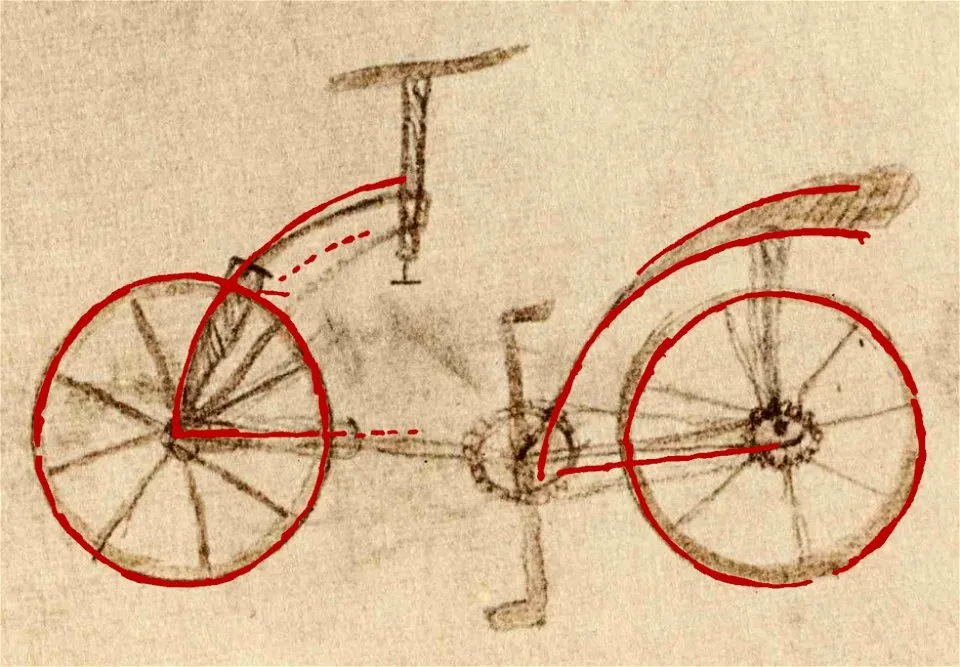
Although Leonardo da Vinci conceived the bicycle first, he was not the first to actually create one by himself. In the 1970s, while Codex Atlanticus was being restored, the bicycle sketch was actually found.
The bicycle started in Germany in the 1800s, according to a physics professor named Hans-Erhard Lessing, who told us in 1998 that the idea was a hoax and anticipated the more well-known viewpoint.
Whence the First Bicycle Was Invented: The Draisine Era (1817–1819)
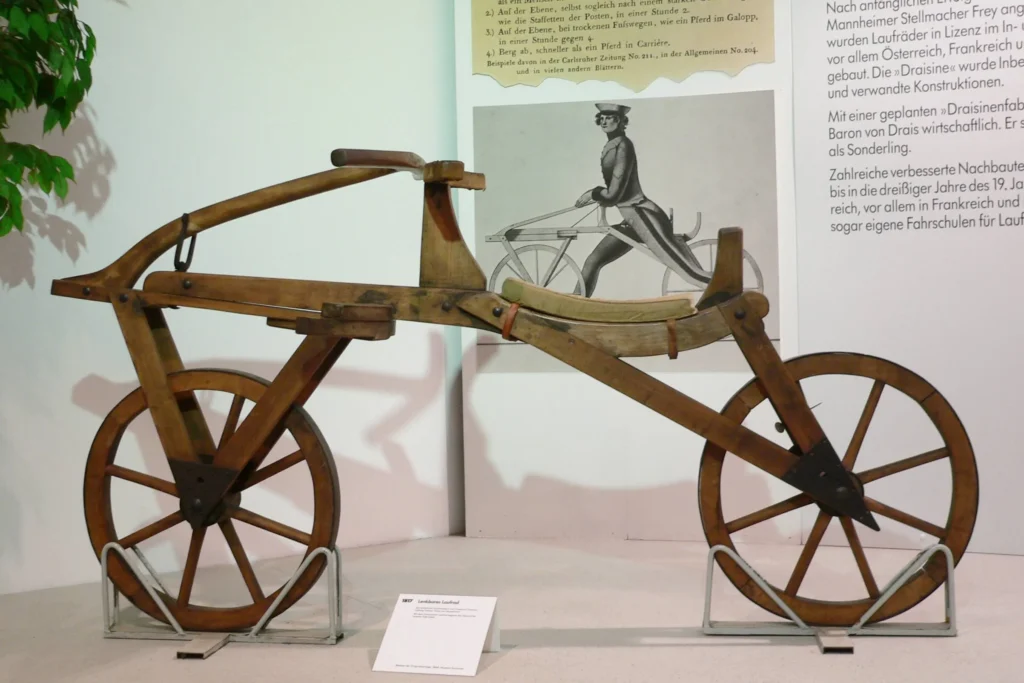
The lack of actual horses inspired Karl von Drais to create his invention. The eruption of Mount Tambora in Indonesia in 1815 caused an ash cloud to spread over the globe, lowering global temperatures. Smithsonian Magazine reports that numerous animals, including horses, perished from famine as a result of crop failure.
Bicycles have come a long way from Drais’ hobby horses, which were more like horses than the aerodynamic speed machines we have today. This old bicycle weighed somewhat around fifty pounds (twenty-three kilos) and had two wooden wheels fixed to a wooden frame. With a simple pair of wooden handlebars, riders controlled the vehicle while sitting on an upholstered leather seat that was fastened to the frame. Riders just had to push the contraption forward with their feet; as there were no pedals or gears in this early bicycle.
Who Invented the Bicycle, and How Did It Develop in the Early 19th Century?
1819 is commonly referred to as the hobby horse period.
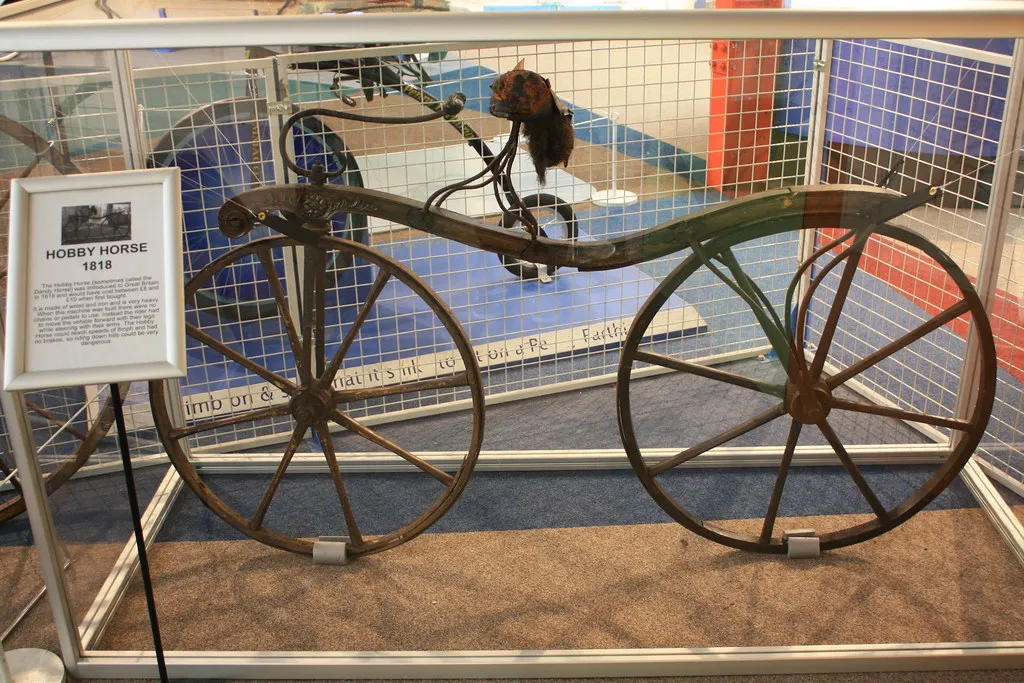
Drais brought his creation to England and France, where it gained traction. The London aristocracy who were looking for pleasure of convience were sold “pedestrian curricles,” a version manufactured by Denis Johnson, a British coach builder.
The two-wheeled bicycle had several parts changed with lighter metal ones as it was constructed of less material than the wooden one.
Prior to being outlawed from sidewalks due to hazard to pedestrians, hobby horses were quite successful for a number of years. The NMAH (National Museum of American History) states that as the trend waned, the bikes were hardly ever seen again by the 1820s.
Bicycles with three or four wheels were popular from the 1820s through the 1850s.
While many advancements were made during the 1820s to 1850s, which are regarded as the “inventing decades,” a number of 3- and 4-wheel bicycle designs with pedals, treadles, and hand cranks were still unsatisfactory because of their increased weight and high rolling resistance capacity.
Willard Sawyer of Dover created a four-wheeled, treadle-operated bicycle in the 1850s, and he sold them all over the world.
In the 1830s, Scottish innovations were made.
Although some people asserts a Scottish Blacksmith created the first two-wheeled vehicle with propulsion in 1839, his nephew asserts that his uncle constructed a rear-wheel bicycle with a treadle attached to a crank via rods.
Although Davin Dalzell claimed to have created a comparable machine in 1845, it was discovered that he had stolen the concept in order to grow his local drapery company. For now, the Glasgow Museum of Transport retains the duplicate design.
Innovations in Bicycle Design during late 90s:
During the 1860s, Boneshaker bicycle was created, which used pedal power.
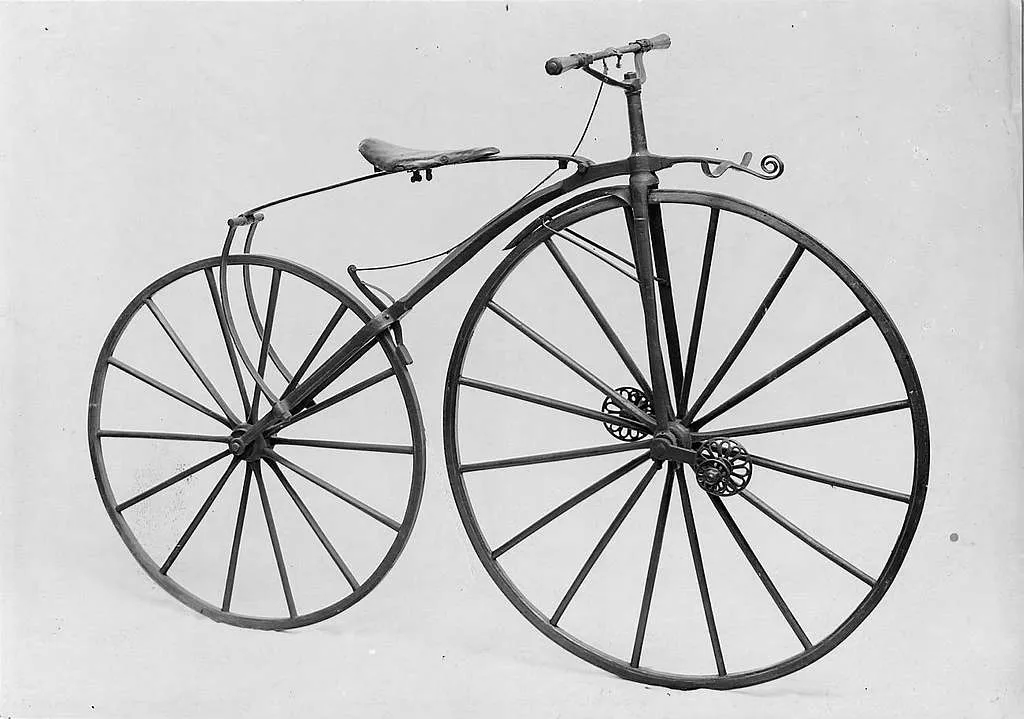
Early in the 1860s, a wooden device featuring two steel wheels, pedals, and a fixed gear system indicated the return of bicycles. Often referred to as a “bone shaker” or velocipede (quick foot), the courageous individuals who utilized this pioneering device were to experience a rough journey.
Lallement displayed his invention in public in 1864, which may have been the reason why Aime and Rene Olivier, two well-to-do Parisian industrialists’ sons, learnt of it and chose to construct their own velocipede. The young men hired coach and blacksmith Pierre Michaux, together with a classmate named Georges de la Bouglise, to construct the pieces they required for their design.
In 1867, Michaux and the Olivier brothers started selling their pedal-powered velocipede, and the invention quickly gained popularity. The bicycle had a tricycle-like appearance with its cranks and pedals attached to the front wheel.
The design was quickly introduced in the US after employee Pierre Lallement of Michaux’s claim to the idea’s credit. He claimed to have created the prototype for the USA as early as 1863.
The firm Michaux and the Oliviers formed together eventually disintegrated due to differences in design and finances, but the Compagnie Parisienne, which the Oliviers owned, continued.
Creation of High-Wheeled Bikes: In the 1870s.
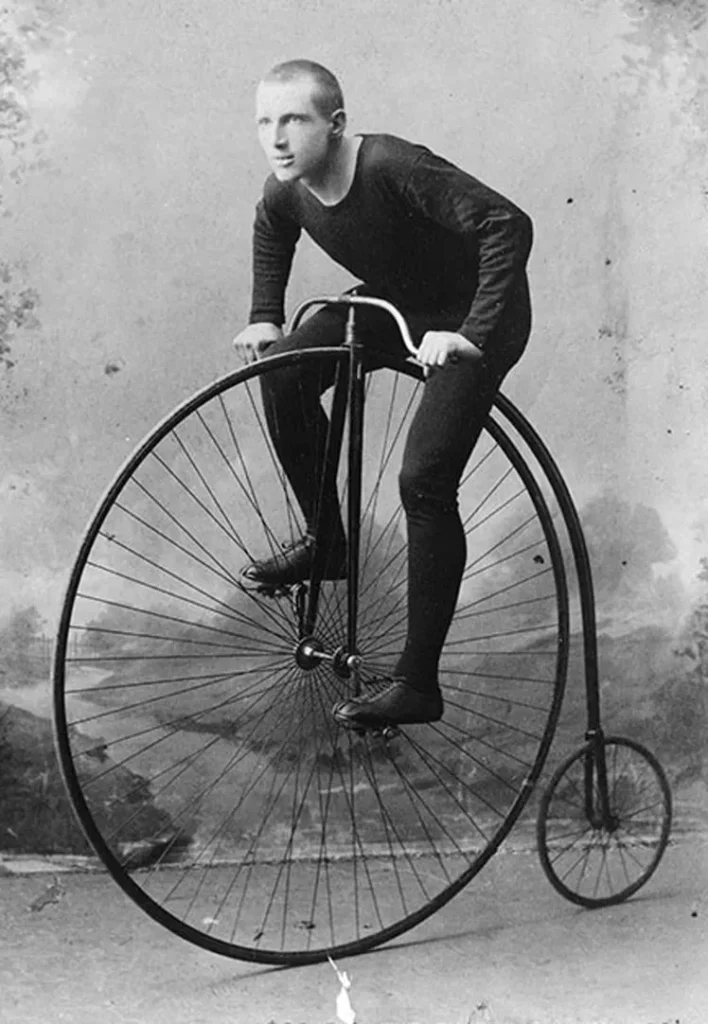
Manufacturers replied with different designs in 1870 when bikers were dissatisfied with Michaux’s hefty bone-shaker design.
Due to the size of the wheels, one well-liked design was of the high wheeler, sometimes referred to as the penny farthing. (A British coin valued one-fourth of a penny was called a farthing.)
Because of its lengthy spokes and sturdy rubber tires, a penny farthing rose more smoothly than its predecessor. When manufacturers discovered that a larger wheel allowed for a greater distance to be covered with a single pedal movement, front wheels grew increasingly larger. Anyone who was passionate about cycling was able to find a wheel which was as long as their legs.
The huge front-wheel design, however, was unpractical for most riders and was only supported by thrill-seeking young men, many of whom started racing these devices at newly established cycling clubs near Europe. In the event of an unexpected halt, the rider would crash on his head as momentum propelled the entire high wheeled Bicycle over the front wheel.
John Kemp Starley: invention of modern bicycle.
Before a successful invention of a “safety bicycle” by an Englishman named John Kemp Starley in the 1870s, interest for penny-farthings remained limited.
After introducing the “Ariel” bicycle to Britain in 1871, Starley started successfully selling his bicycles and established that country as the leader in bicycle invention for many years to come.
The tangent-spoke wheel, which Starley invented in 1874, is arguably his most well-known innovation. For the first time in history, riding a bike was made (at least partly) pleasant and joyful thanks to the tension-absorbing front wheel, which was a significant advance above the wheels seen on prior bicycles. Additionally, compared to earlier versions, the bike was significantly lighter thanks to Starley’s wheels.
Then Starley unveiled the “Rover” in 1885. As the first truly practical bicycle, Starley’s “Rover” was incredibly stable because to its almost equal-sized wheels, center pivot steering, and chain-driven differential gears.
According to the NMAH, bicycle usage increased dramatically from an estimated 200,000 in 1889 to 1 million in 1899.
Invention of pneumatic tyre.
The invention of pneumatic rubber tires in 1888 gave bicycles a significant advance. Although it may appear little, this innovation would have reduced weight and improved riding comfort. Smoother, more elegant walking over cobblestones.
Scottish veterinary surgeon John Boyd Dunlop was a resident of Belfast. According to his son, his father overcame an issue with his bicycle commute to school by creating an inner tube known as a pneumatic tire.
That tire was inserted between treads and an outer rubber tire. But due to a prior invention that Robert William Thompson had developed, the patent was already invalidated two years prior.
Safety Bicycles for Women
A Victoria model bicycle, also called a lady’s safety bicycle, was produced in the 1890s by the Boston Overman Wheel Company. It was built with penny farthings in place of equal-sized wheels, although the nameplate had a patent date spanning from November 20, 1887, to July 9, 1889.
The drop frame design of the safety bicycle made it possible for women to ride in their skirts with ease. Because it was now legal for both men and women to ride bicycles, the bicycle business saw an incredible growth in the 1890s.
Ladies’ dress had to undergo drastic adjustments as more and more women began to ride. Bloomers were popular because they allowed women to wear long skirts that concealed their legs while yet providing them with greater movement than bustles and corsets.
Since more women began to ride bicycles on the streets in the 1890s, there has been speculation that the bicycle had a major role in “killing the corset.”
When and by whom was the battery-powered bicycle invented?
In 1895, Ogden Bolton Jr. created the first bicycle that ran on batteries.
His battery-powered bicycle, model number 552,271, with a 6-pole direct-current motor shaft located on the back wheel, was granted a U.S. Patent that same year. With just a 10-volt battery, the engine can generate up to 75 amps, and it is gearbox-free.
A bicycle with an installed motor—which may power the machine or assist with pedaling—is referred to as a “motorized bicycle.” This invention encouraged other innovators to develop other varieties of electric bicycles by utilizing different forms of power support.
Easily stored and transported within buildings or on public transportation, the foldable electric bike is the newest design in bicycles. Its frame can be folded into a tiny package.
The Evolution and History of Bicycle Brakes:
In 1896, coaster brakes were invented.
Coaster brakes, sometimes known as foot brakes or back pedal brake pads, are standard equipment on most children’s bicycles. Their low maintenance needs and straightforward design make them a popular choice among bike owners.
Identifying a coaster brake bike is very easy because the brake arm is attached to the handlebar stem. Riding backwards on a bike engages the coaster brake, which is a braking system. Therefore, coaster brakes are also known as backpedal brakes. Most commonly, they may be seen on cruiser bikes for adults and kids, but not on more specialized bikes like road or mountain bikes.
Abram W. Duck created brakes in 1897 to increase stopping force.
Developed in 1897, the duck brake spared some of the wear that newer, more modern rubber tires experienced. It worked similarly to the spoon brake. Duck brakes are the newest innovation to bicycles.
When the rider releases a lengthy lever, two rollers drop against the front tire to generate a duck brake. An increased amount of tyre contact is ensured by the tool rollers rather than by a single spoon, and the lever increases the effort needed by the rider to achieve a stop.
Cycling on slick pavement is much more convenient with these. However they’re not working anymore.
Innovations in Bicycle Design during early 20s
Electric bike traction detectors
When electric motorbikes started to revolutionize transportation in the 1900s, traction detectors and output controls first became available. A pedal assistance, also called a pedelec, was invented by Michael Kutter.
Kutter and the Velocity Company collaborated in 1992 to design the Dolphin electric bicycle for consumers. With today’s electric bikes, this innovation is standard. Certain bicycle companies could use pedal-assist, throttle, or both technology into their designs.
In 1917, Howard Hughes founded Houston.
Despite being a well-known billionaire now, Howard Hughes powered his bicycle as a child using a lead-acid car battery and a 6-volt electric starter motor from a vehicle.
Using his father’s motor components, Howard Hughes, then 12 years old, assembled what the press called Houston’s first motorized bicycle. It helps the rider to get adequate traction to avoid slipping when traveling at a fast speed or over a wet patch of pavement.
Mountain Bikes: Who Found Them?
In 1979, Joe Breeze invented the first mountain bike, bringing innovation to the cycling industry.
Joe Breeze has had a significant role in the development of mountain biking. The reason he is best known is that he designed and made the first widely used modern mountain bikes. His own-designed Breezers were the first modern mountain bikes with robust frames.
Joe was building road racing frames. He was still having fun riding the dirt with friends on old Schwinns and other balloon-tired clunkers. But such damage was not intended to be sustained by the original frames.
They were breaking in addition to being heavy. Joe Breeze worked on a number of breakthroughs in components. These included the Unicrown fork design and the novel Breeze & Angell Hite Rite saddle adjustment, one of the original pieces of gear for the new sport.
Eric Staller’s 1991 Conference Bike
The conference bicycle has three wheels and can accommodate seven riders. It was made a long time ago by Eric Staller, an artist. They are also used in businesses, colleges, and counseling to provide employees a place to socialize and build a feeling of community.
There is a circularly connected drive shaft and rack-and-pinion steering on the bike. The bulk of the eighteen nations have granted ConferenceBikes the same legal status as bicycles. Over 300 of these bikes have already been sold.
ADAPTRAC: An Advanced Tyre Pressure Controller for Bicycles
ADAPTRAC is a metal frame pressurized air system that allows mountain bikers to modify the amount of compressed air in their tires. By placing a control mechanism on the handlebar, riders may increase or decrease the amount of air in their front or back tires?
Mounting that gadget can alternatively be supported by the stems or lower tubes. Still, there have been significant experimental advances in the last several years, along with the introduction of novel ideas such as computerized suspension damping, hydraulic gearboxes, and falling seat posts.
The state-of-the-art in mountain bike technology is the Adaptrac system, which lets the rider to quickly adjust the pressure in their tires and adapts to their ever-changing traction needs.
Bicycle’s Today
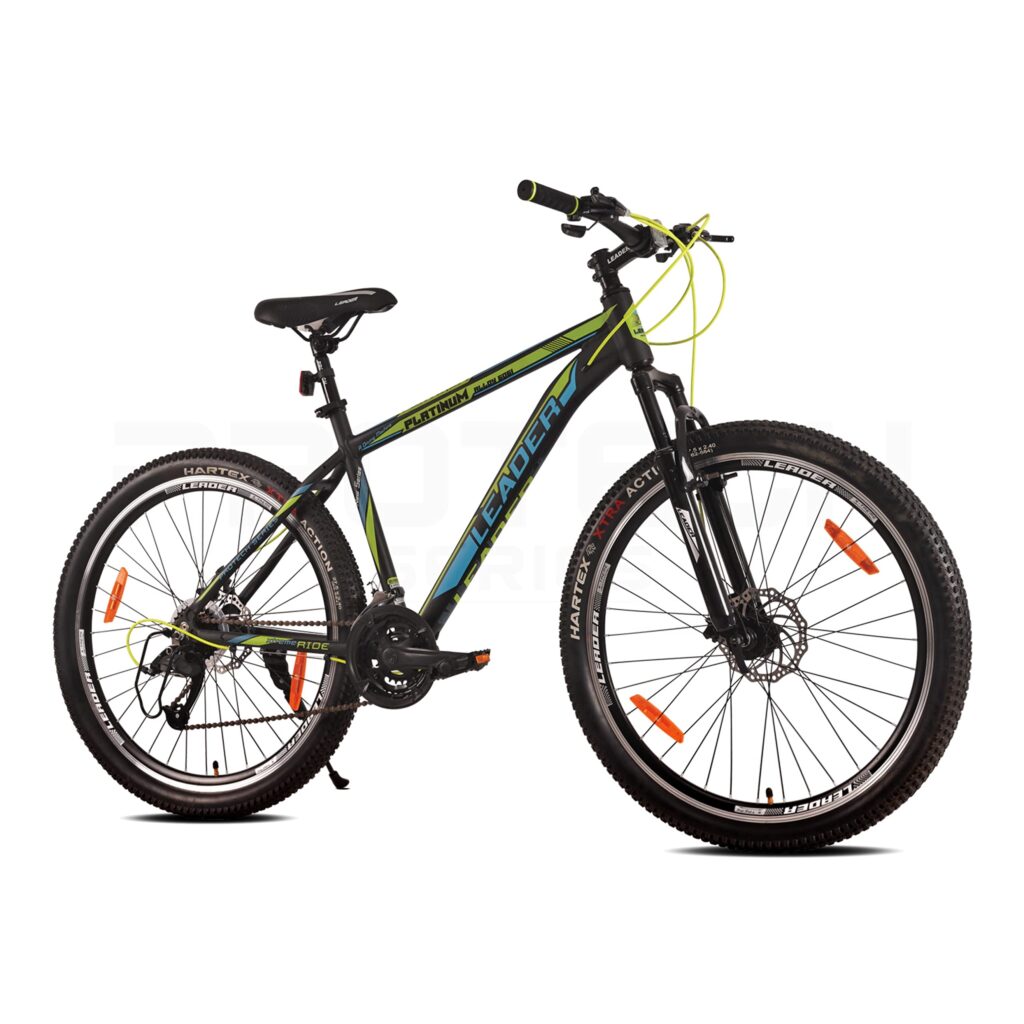
With all the advancement over the years, there are a lot of alternatives available to someone entering a bicycle store these days. Different materials are used in the design and construction of bicycle frames depending on the intended riding location.
Bike Bamboo claims that they can be made from bamboo in addition to more conventional materials like steel, aluminum, titanium, and carbon fiber. To roll over a range of surfaces, including smooth, paved city streets and rugged, dirt-covered mountain routes, wheels are available in a variety of sizes and thicknesses.
Riders have a variety of options when it comes to brakes, gear ratios, seat forms, handlebar bends and locations, and suspension.
There is no limit to the number of gears on a bicycle. For racing, seats might be small and tight, or they can be large and padded for enjoyable journeys. On uneven terrain, suspension can be fitted for a better ride.
Furthermore, some contemporary bicycle designs are so unlike from their forebears that early creators probably wouldn’t have recognized them as bicycles. Bicycles these days are able to fold up which facilitate storage or transportation much easier than before.
Some cycles have no seats and look like gym elliptical machines; others have strollers connected so you can ride with little children; yet others have electric engines.
Frequently Asked Questions: The Bicycle’s Evolution and History
Q1. When was the first geared bicycle made, and who made it?
In 1978, American inventors Scott and Phillott created a brand-new type of bicycle known as the gear-changing cycle.
Patented by Scott and Phillott, the geared bicycle’s front wheel included the first operational epicyclic gear speed changing design. Weed Weaving Manufacturing Company’s Hartford factory produced the first bicycle made in the United States, the Columbia.
Q2. Who came up with the idea for the pedal crank on the bicycle?
Pedal cranks were devised in 1853 by Phillip Moritz Fischer. At the age of nine, he was the one who utilized Draisine to attend school. He returned to his homeland of Schweinfurt after spending years living in London, where he built the first bicycle with pedals, which is currently on public exhibit at the Schweinfurt Municipal Museum.
Q3. Why and when BMX became so popular?
Due to its unique design and 16–24-inch wheels, which were initially manufactured in California in the early 1970s, BMX bikes had great popularity in the 1980s. They were lightweight bicycles that were convenient to use in both country and urban settings.
The Schwinn StingRay, a tough bicycle model with strengthened springs and robust tyres, was the only model considered when designing BMX bikes. Their design was entirely centered on weight. It is safe to drive BMX bikes quickly on uneven ground.
Final Thoughts on Who Invented the Bicycle
The bicycle innovation is finally brought to a close in this piece, and maybe you now know who invented it. The first bicycle was created by German Baron Karl von Drais from wood, and other individuals continued to modify it until John Kemp Starley created the modern bicycle in 1885.
This has led several bicycle manufacturers to produce a wide range of bicycles, making riding enjoyable and comfortable. Currently available bicycle types include road bikes, hybrid bikes, mountain bikes, BMX bikes, touring bikes, and many more. Additionally, the characteristics and functions of each type of bike vary.
We appreciate you reading this article through to the end. Please share this article about the history of bicycles if you found it interesting! Please tell your friends and family about this.
Resources:
- Magazine, Smithsonian. “Blast from the Past.” Smithsonian.com, Smithsonian Institution, 1 July 2002,
- “America on the Move.” National Museum of American History, 3 July 2019, .
- LiveScience. “Who invented the bicycle.?” Livescience.com, 4 March 2022.


0 Comments